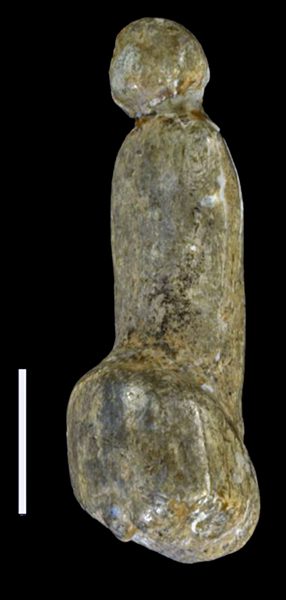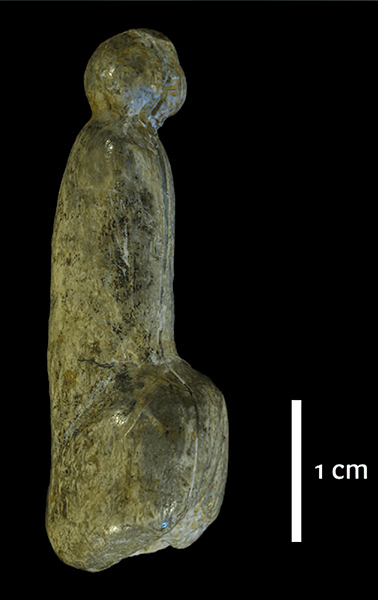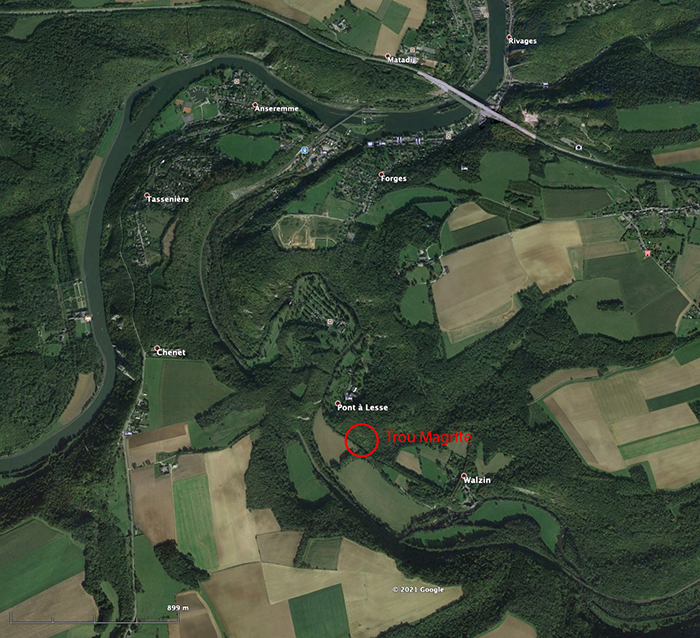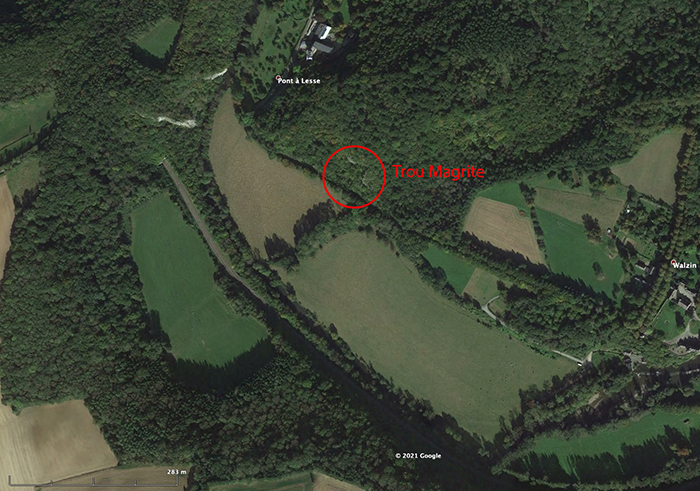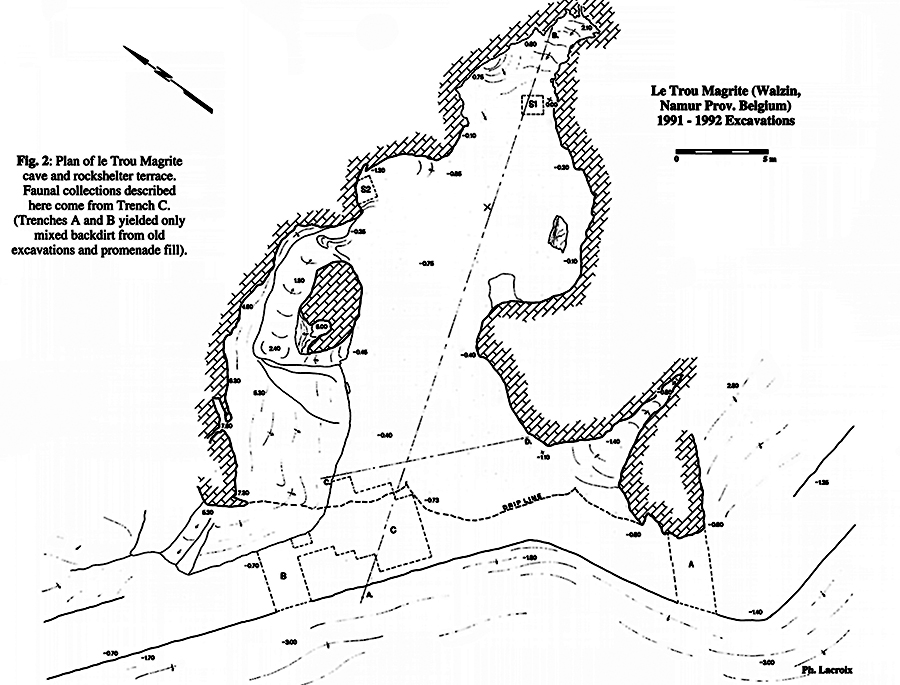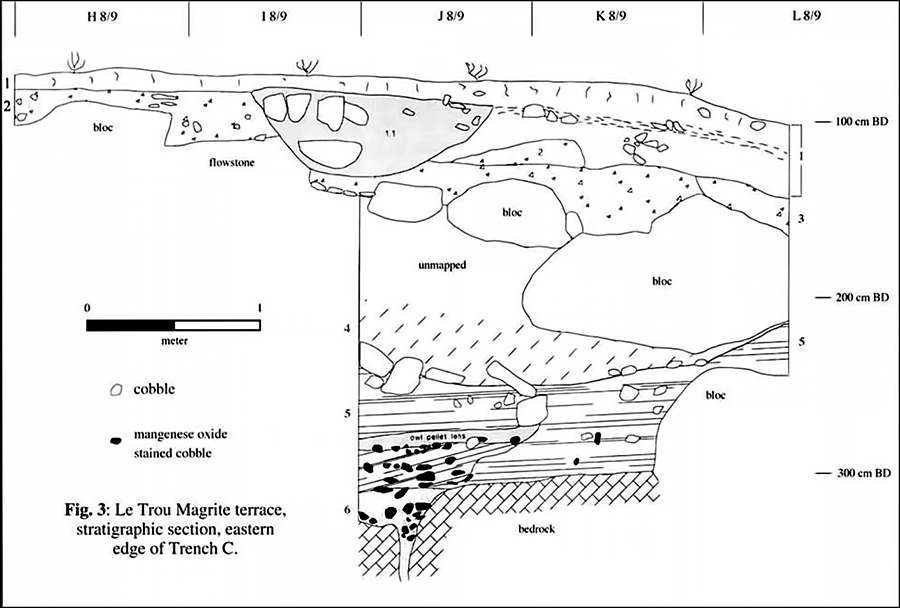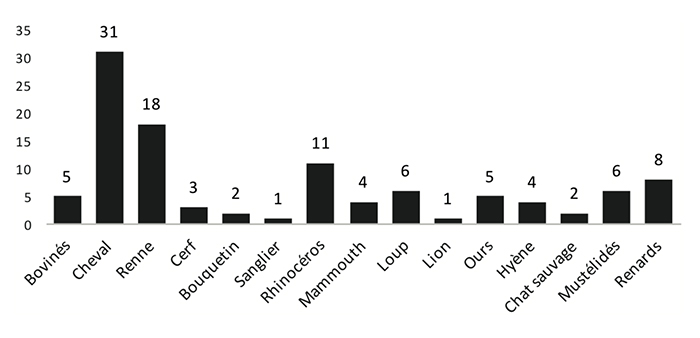Back to Don's Maps
Back to Venus figures from the Stone Age
The Trou Magrite / Magritte Venus
This 38 mm high ivory statuette was discovered by Dupont (1873) in 1867 during excavations conducted in the 19th century in the Trou Magritte/Magrite near Dinant. In 1991 and 1992, a new excavation campaign was launched. It made it possible to date the statuette, which had previously been attributed to the Gravettian period, to the Aurignacian period.
The faunal assemblage is dominated by (% Number Identified Specimens): Horse (34.1%), Reindeer (25.7%), and Rhinoceros (11.3%). The large carnivores are represented by Canids (3%) and Hyaenas (2.3%)
(left) Photo and computer graphics: Patrick Semal, IRSNB.
Proximal source: Institut Destrée (2011)
Additional text: Jimenez (2016)
(right) Photo: http://paleo-art.naturalsciences.be/EN/venus/venus.html
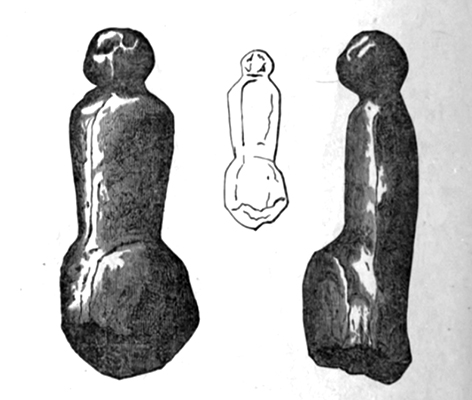
The venus as published by Dupont, with the description:
Carved objects were found in the third ossiferous layer of the Trou Magrite. The first is a rough-out, a first draft, of a 4-centimetre high reindeer antler figurine from the upper layers of the mammoth era.
Dupont goes on to say:
None of the caves excavated in the vicinity of Dinant presented itself more favourably for a human habitation than the Trou Magrite, at Pont-à Lesse. It is a very dry, vast, wide-open, well-lit, well oriented cave.
Source: Dupont (1873)

Édouard Dupont.
Source: Jimenez et al. (2016)
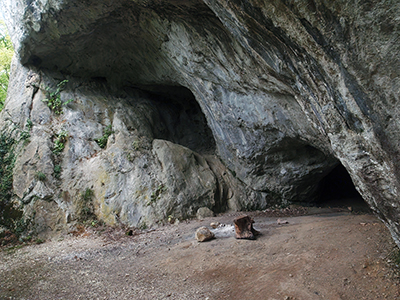
Entrance to Trou Magrite
Photo: Groupe Spéléo la Corde Dinant
Source: http://speleodinant.blogspot.com/2011/09/
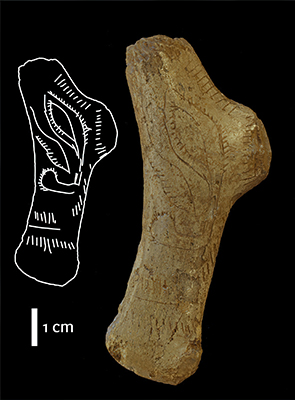
Another important find was this engraved reindeer antler baton.
Photo: 2015, RBINS, DIGIT-03 & ADIA
Source: http://paleo-art.naturalsciences.be/EN/objets/magrite.html#core
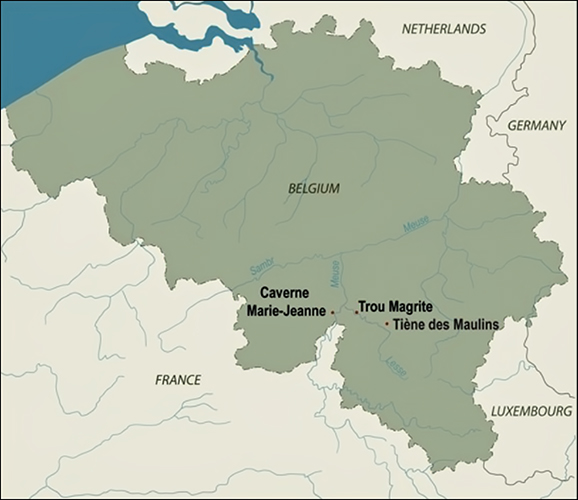
Localities of some important sites in the Meuse Valley of Belgium.
1: Tiène des Maulins
2: Trou Magrite
3: Caverne Marie-Jeanne.
Map: N. Bloch, modified
Source: Jimenez (2016)
Location of Trou Magrite.
Click on any image to get the full size image.
Map: © Google Earth
Plan of the excavations of 1991 - 1992 at Trou Magrite.
Drawing: Ph. Lacroix
Source: Gautier et al. (1998)
Le Trou Magrite terrace, stratigraphic section, eastern edge of Trench C, excavations of 1991 - 1992 at Trou Magrite.
Source: Gautier et al. (1998)
| Excavations at Trou Magrite | |||||||
|---|---|---|---|---|---|---|---|
| Dupont and Rutot Excavations | Toussaint Test Pit | Otte & Strauss Excavations | |||||
| Geology | Layers | Archaeology | Geology | Period | Layers | Geology | Period |
| Boulder clay | Excavations dating from 1840 | Collapsed blocks | Disturbed layers: Iron Age, Upper Palaeolithic, Mesolithic |
Level 1 | Mixture of spoil and humus | ||
| Level 1.1 | Pit that begins level 2, silt filling | Neolithic, Mesolithic, Magdalenian | |||||
| Stratified silts | Upper ossiferous levels (partially destroyed during excavation): Levels 1 and 2 |
Lithic industry on blades, 'knives', tools with detached stalk/peduncle, fauna intermediate between the Reindeer Age and the Mammoth Age |
Clay-silt deposits | Aurignacian | Level 2 | Cryoclastic scree | Aurignacian |
| Level 3 | Cryoclastic scree | Aurignacian | |||||
| Lower ossiferous layers: levels 3 and 4 |
Large flint, siliceous shale and black marble flakes Mammoth Age fauna Anthropomorphic figurine and engraved reindeer antler (level 3) |
Middle Palaeolithic | Level 4 | Brownish-yellow clayey silt with large limestone blocks |
Middle Palaeolithic | ||
| Rolled pebbles | Archaeologically sterile, occupation by carnivores | Rolled pebbles | Sterile | Level 5 | Heterogeneous loess layer of fluvial origin (microfauna + raptor [ owl ] droppings) |
Middle Palaeolithic | |
| Level 6 | Gravel, sand, and pebbles, fluvial origin |
Sterile | |||||
| Fauna of Trou Magrite | |||
|---|---|---|---|
| Common Name | Scientific Name | Number | Comment |
| Mammoth | Mammuthus primigenius | 3 | One adult, one younger, one very young |
| Wooly Rhinoceros | Coelodonta antiquitatis | 8 | |
| Wild Boar | Sus scrofa | 3 | |
| Horse | Equus ferus | 17 | |
| Chamois | Rupicapra rupicapra | 2 | |
| Reindeer | Rangifer tarandus | ≥ 30 | |
| Red Deer | Cervus elaphus | 3 | |
| Roe Deer | Capreolus capreolus | 2 | |
| Ibex | Capra ibex | 3 | |
| Goat | Capra aegagrus | 10 | |
| Aurochs | Bos primigenius | 5 | |
| Marmot | Marmota marmota | 3 | |
| Hare | Lepus europaeus | 6 | |
| Beaver | Castor fiber | 1 | |
| European water vole | Arvicola amphibius | 1 | |
| Norwegian Lemming | Lemmus lemmus | 2 | Listed by Dupont as the Norwegian rat, with the scientific name Lemnus, the alternative identification I give here seems more likely - Don |
| Cave Lion | Panthera spelaea | 1 | |
| Eurasian Lynx | Lynx lynx | 1 | Listed by Dupont as Engihoul's lynx, with the scientific name Felis Engiholiensis, this name has not been used since the 19th Century, and has been replaced by Lynx lynx - Don |
| European Wildcat | Felis silvestris | 2 | |
| Cave Hyena | Crocuta crocuta spelaea | 4 | |
| Red Fox | Vulpes vulpes | 11 | |
| Eurasian wolf | Canis lupus lupus | 4 | |
| European Weasel | Mustela nivalis | 1 | |
| European Badger | Meles meles | 3 | |
| Rock ptarmigan | Lagopus muta | 4 | |
| Capercaillie | Tetrao urogallus | 1 | |
| Black Grouse | Lyrurus tetrix | 1 | |
| Mallard | Anas platyrhynchos | 2 | |
| Other birds | Undetermined species | not specified | |
| Freshwater Fish | Undetermined species | not specified | |
Minimum Number of Individuals from the excavations of Dupont at the Trou Magrite.
From left to right:
Bovines, Horse, Reindeer, Deer, Ibex, Wild Boar, Rhinoceros, Mammoth, Wolf, Lion, Bear, Hyena, Wild Cat, Weasel, Fox.
Source: Jimenez et al. (2016)
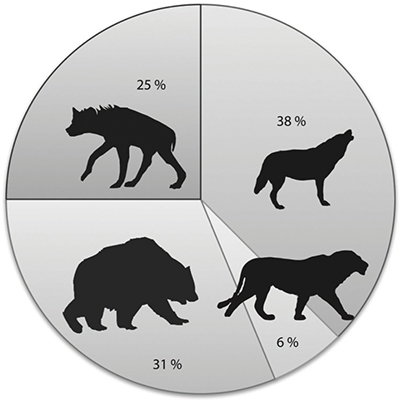
Representation of each species within the spectrum of large carnivores identified at Trou Magrite.
Source: Jimenez et al. (2016)
From Dewez (1985) :
The Trou Magrite is a beautiful cave in the valley of the Lower Lesse, situated in such a picturesque site in the 19th century that its owner at the time, M. de Villers-Masbourg, decided to turn it into a 'pleasure cave'.
To do this, it had to be enlarged and around 1840 about one metre of Quaternary soil was removed from the entire surface. Dupont was the first to undertake prehistoric research in 1864-1865. He carried out a complete excavation down to bedrock in 1867.
Numerous researchers continued to frequent the site and carry out excavations, such as Rahir in 1908 (Rahir, 1928: XIII) and probably Rutot in 1913-1914 (according to Angelroth, 1939: 149), but without publishing the results of their research. Amateurs regularly came to stir up the rubble to collect collection material; finally, in 1976, M. Toussaint carried out a final check on the terrace and a verification of the veneer of the walls. Only the information provided by Dupont is likely to shed light on the stratigraphy of the palaeolithic layers he encountered.
References
- Delporte H., 1993: L'image de la femme dans l'art préhistorique, Paris.
- Dewez M., 1985: L' art mobilier paléolithique du Trou Magrite dans son contexte stratigraphique Bull. Soc. roy. belge Anthrop. Préhist., ,96 :I l7-133, 1985
- Dupont É., 1873: Les temps préhistoriques en Belgique : l'homme pendant les âges de la pierre dans les environs de Dinant-sur-Meuse, Published in 1873 in Bruxelles by C. Muquardt.
- Gautier A., Cordy J., Straus G., Otte M., 1998: Taphonomic, chronostratigraphic, paleoenvironmental and anthropogenic implications of the Upper Pleistocene faunas from Le Trou Magrite, Belgium ANTHROPOZOOLOGICA, 25-26 - PAGES 343-354
- Institut Destrée, 2011: Manuel d’histoire de la Wallonie Chapitre 01., Préhistoire et Protohistoire, Synthèse 17 juillet 2011
- Jimenez E., 2016: Palaeoecology and Subsistence Strategies in Belgium and Northwestern Europe during the MIS 3 through the Reassessment of Forgotten Collections: A Methodological Approach, Papers from the Institute of Archaeology, 25(2): Art. 18, pp. 1–8, DOI: http://dx.doi.org/10.5334/pia-486
- Jimenez E., Smolderen A., Jadin I., Germonpré M. , 2016: Exhumation de la collection faunique d’Édouard Dupont provenant du Trou Magrite (Pont-à-Lesse) Quelles données et quelles perspectives pour une collection do XIXe siècle?, Notae Praehistoricae, 2016;36:167–190.
